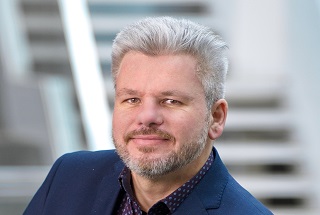"The EU Chips Act will open up new opportunities for us"

What successes can the "Electronic Materials and Components" business unit look back on in 2023?
First of all, I would like to mention what is our core business, namely the successful completion of projects. We have achieved important results in "UltimateGaN" for the possible applications of gallium nitride in microelectronics and have also started a follow-up project, "All2GaN". For the establishment of new acoustic and thermographic methods for defect localization in complex 3D packages, "FA4.0" has provided valuable insights into the possible applications of machine learning. The results of the "iREL4.0" project also expand our methodological expertise for reliable power electronic components, from which our customers will benefit. The CAM workshop that we organized was once again a highlight in our calendar of events. For the tenth edition of the event, we were able to attract keynote speakers from Intel, Volkswagen and IMEC, among others, and took the opportunity to engage in a high-caliber exchange with customers, colleagues and device manufacturers. For me personally, the role as General Chair of the International Symposium for Testing and Failure Analysis (ISTFA) was as labor-intensive as it was fulfilling. We were represented at this international conference with five papers and three tutorials, which I consider to be a very gratifying appreciation of our expertise. As part of the institute-wide hydrogen activities, we focused on sensor development and the reliability of electronic components for H2 applications and expanded our expertise in these areas.
Which clients does your business unit work with and how can they benefit from working with the Fraunhofer IMWS?
Our customers cover the entire electronics supply chain, from the semiconductor to the assembly and system level. We offer them highly efficient failure diagnostics in microelectronics and can provide a wide variety of methods from a single source. Our knowledge of the microstructure of materials enables us to draw conclusions about the material behavior of the components and their electrical functionality. This is the basis for innovative solutions to improve the reliability, service life and quality assurance of electronic components. For example, we are currently further developing analysis methods involving machine learning for efficiency control and automation and are using our high-resolution analytics to support the introduction of new semiconductor and component technologies.
In 2023, the decision was made to locate an Intel semiconductor plant in Magdeburg. What do you think?
The decision in favor of this location is also a great opportunity for us. We can build on our long-standing cooperation with Intel in the USA. Efficient methods for assessing reliability are just as important in production as they are in research and development. We are constantly developing in this area in order to be able to meet the future needs of our customers. In the interests of the region, we also want to get involved in the microelectronics training of skilled workers in Saxony-Anhalt, who are also needed for the Intel factory.
What are you looking forward to in the new year and what will be a particular challenge in 2024?
I am looking forward to working on new projects, for example on evaluating reliability in power electronics and system integration as well as the use of AI-based methods in fault diagnostics, advanced packaging and hardware security. We will commission new equipment to support the Research Fab Microelectronics Germany in the fields of transmission electron microscopy (TEM) and plasma-focused ion beam, among others. We want to work more closely with the US branch of Fraunhofer on the subject of diamond technologies. The EU Chips Act will also open up new opportunities for us, especially for cooperation with our industrial customers. And of course I'm also looking forward to the CAM workshop again, this time with keynotes from the CEA-Leti in Grenoble and Infineon, among others.